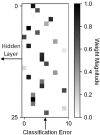Direct Feedback Alignment With Sparse Connections for Local Learning
- PMID: 31178689
- PMCID: PMC6542988
- DOI: 10.3389/fnins.2019.00525
Direct Feedback Alignment With Sparse Connections for Local Learning
Abstract
Recent advances in deep neural networks (DNNs) owe their success to training algorithms that use backpropagation and gradient-descent. Backpropagation, while highly effective on von Neumann architectures, becomes inefficient when scaling to large networks. Commonly referred to as the weight transport problem, each neuron's dependence on the weights and errors located deeper in the network require exhaustive data movement which presents a key problem in enhancing the performance and energy-efficiency of machine-learning hardware. In this work, we propose a bio-plausible alternative to backpropagation drawing from advances in feedback alignment algorithms in which the error computation at a single synapse reduces to the product of three scalar values. Using a sparse feedback matrix, we show that a neuron needs only a fraction of the information previously used by the feedback alignment algorithms. Consequently, memory and compute can be partitioned and distributed whichever way produces the most efficient forward pass so long as a single error can be delivered to each neuron. We evaluate our algorithm using standard datasets, including ImageNet, to address the concern of scaling to challenging problems. Our results show orders of magnitude improvement in data movement and 2× improvement in multiply-and-accumulate operations over backpropagation. Like previous work, we observe that any variant of feedback alignment suffers significant losses in classification accuracy on deep convolutional neural networks. By transferring trained convolutional layers and training the fully connected layers using direct feedback alignment, we demonstrate that direct feedback alignment can obtain results competitive with backpropagation. Furthermore, we observe that using an extremely sparse feedback matrix, rather than a dense one, results in a small accuracy drop while yielding hardware advantages. All the code and results are available under https://github.com/bcrafton/ssdfa.
Keywords: backpropagation; bio-plausible algorithms; feedback alignment; hardware acceleration; local learning; sparse neural networks.
Figures








References
-
- Abadi M., Barham P., Chen J., Chen Z., Davis A., Dean J., et al. (2016). Tensorflow: a system for large-scale machine learning, in 12th {USENIX} Symposium on Operating Systems Design and Implementation ({OSDI} 16) (Savannah, GA: ), 265–283.
-
- Amaravati A., Nasir S. B., Thangadurai S., Yoon I., Raychowdhury A. (2018b). A 55 nm time-domain mixed-signal neuromorphic accelerator with stochastic synapses and embedded reinforcement learning for autonomous micro-robots, in Solid-State Circuits Conference-(ISSCC), 2018 IEEE International (San Francisco, CA: IEEE; ), 124–126.
-
- Amaravati A., Nasir S. B., Ting J., Yoon I., Raychowdhury A. (2018a). A 55-nm, 1.0–0.4 v, 1.25-pj/mac time-domain mixed-signal neuromorphic accelerator with stochastic synapses for reinforcement learning in autonomous mobile robots. IEEE J. Solid State Circuits. 54, 75–87. 10.1109/JSSC.2018.2881288 - DOI
LinkOut - more resources
Full Text Sources

